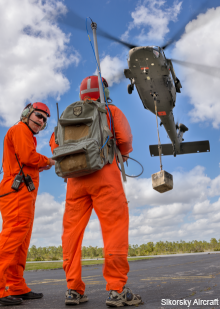Piloting a Black Hawk is optional with experimental system
The Army and Sikorsky Aircraft demonstrate an "optional piloting" system for the fabled helicopter.
The military’s move toward pilotless aircraft is extending even to the Army’s fabled Black Hawk helicopter, which recently completed its first pilotless flight.
The ability to fly on its own doesn’t make it a drone, of course. The test flight demonstrated “optional piloting,” which gives the flight commander another choice during a mission, according to Sikorsky Aircraft Corp., which conducted the test along with the Army at the company’s Development Flight Center. Autonomous options in-flight is something the Pentagon is pursuing in an effort to reduce crew sizes and increase efficiency.

The hover-and-flight test of the Optionally Piloted Black Hawk (OPBH) Demonstrator, was conducted with Sikorsky’s Manned/Unmanned Resupply Aerial Lifter (MURAL), a joint project of Sikorsky, the Army Aviation Development Directorate and the Army Utility Helicopters Project Office.
“The autonomous Black Hawk helicopter provides the commander with the flexibility to determine crewed or un-crewed operations, increasing sorties while maintaining crew rest requirements,” Mark Miller, the company’s vice president of research & engineering, said in a release. “This allows the crew to focus on the more ‘sensitive’ operations, and leaves the critical resupply missions for autonomous operations without increasing fleet size or mix.”
Sikorsky has been developing autonomous capabilities since 2007 and in 2013 introduced its Matrix technology, which is designed to give rotary and fixed-wing vertical landing and takeoff (VTOL) aircraft the ability to conduct complex missions on their own. Using Matrix with the OPBH is a step toward shows the ability to apply autonomous capabilities across a range of aircraft, Sikorsky said.
The Army/Sikorsky test continues the development of autonomous flight systems, whether they’re used in manned or unmanned aircraft.
The Defense Advanced Research Projects Agency is looking to develop a drop-in kit, under its Aircrew Labor In-Cockpit Automation System (ALIAS) program, that would be capable of managing flight activities, conducting failure management and carry enough of the operational load to allow an operator to act as a mission commander, rather than a pilot. ALIAS aims to reduce a pilot’s workload and reduce the size of a crew while increasing efficiency and improving safety.
Meanwhile, DARPA also is working on the VTOL Experimental Plane, an unmanned hybrid capable of taking off and landing like a helicopter but have the speed and range of a plane. And the agency’s ARES program would develop modular VTOL drones whose configurations could be easily swapped, depending on the mission.
NEXT STORY: DISA exercises option on C2 modernization